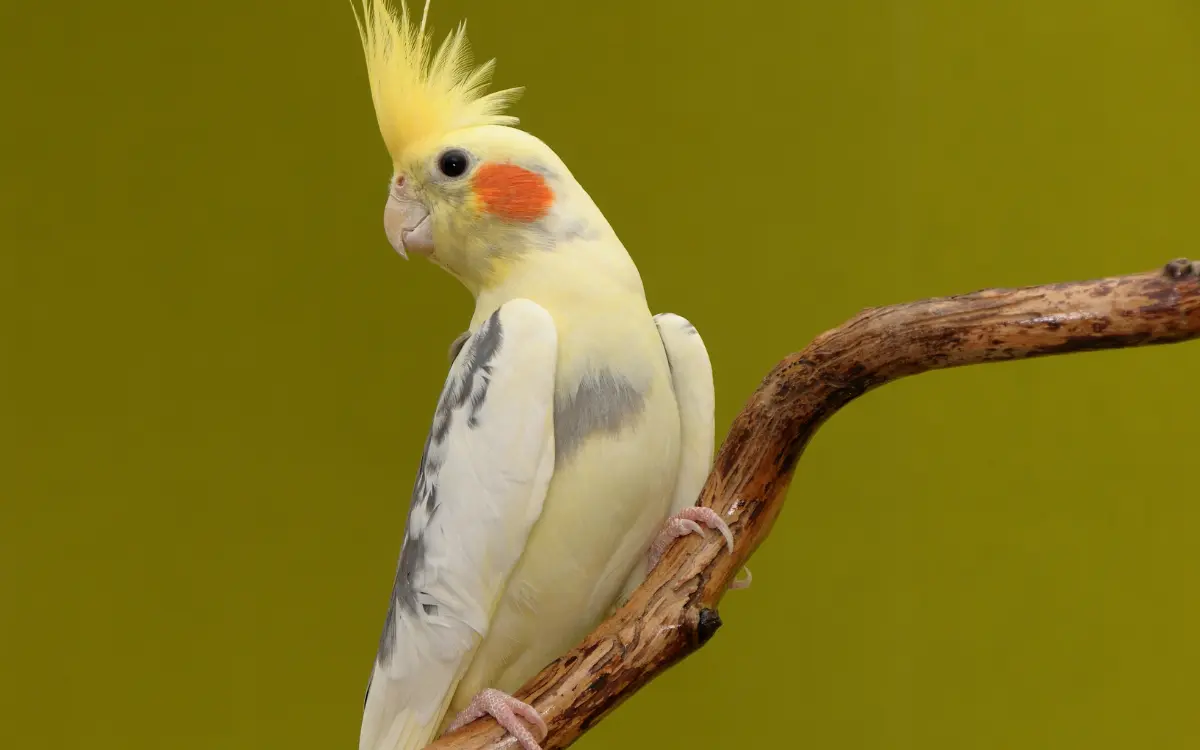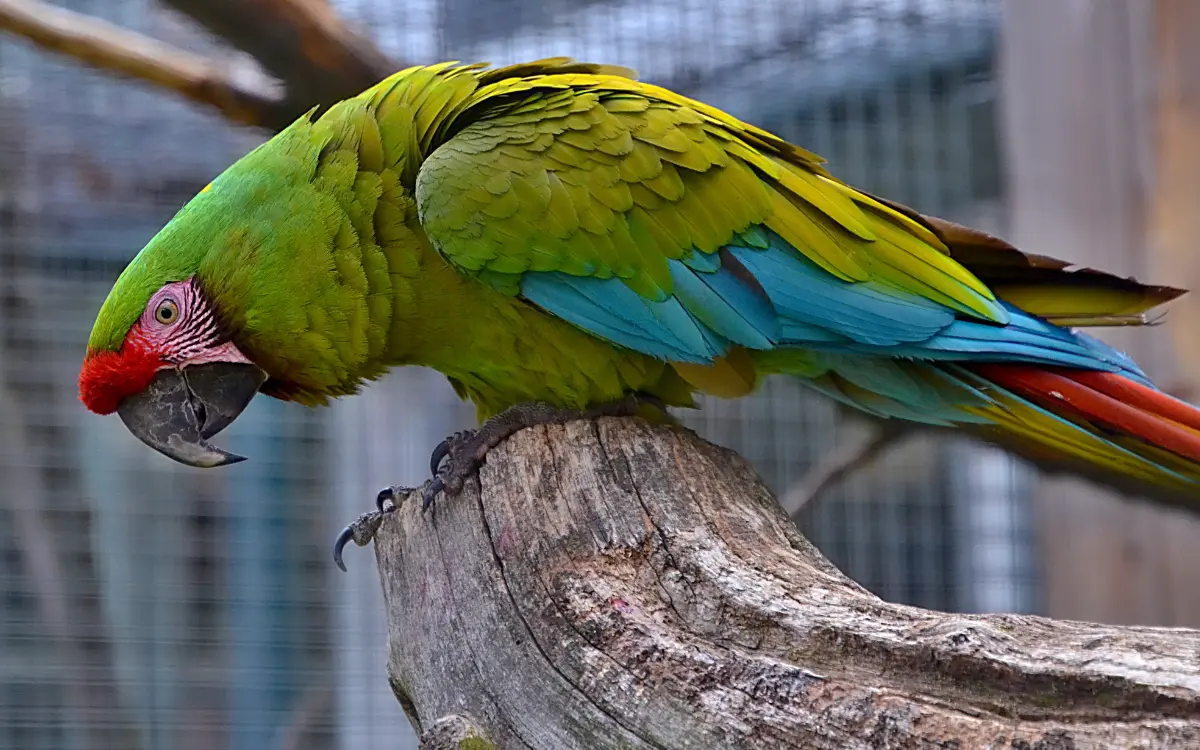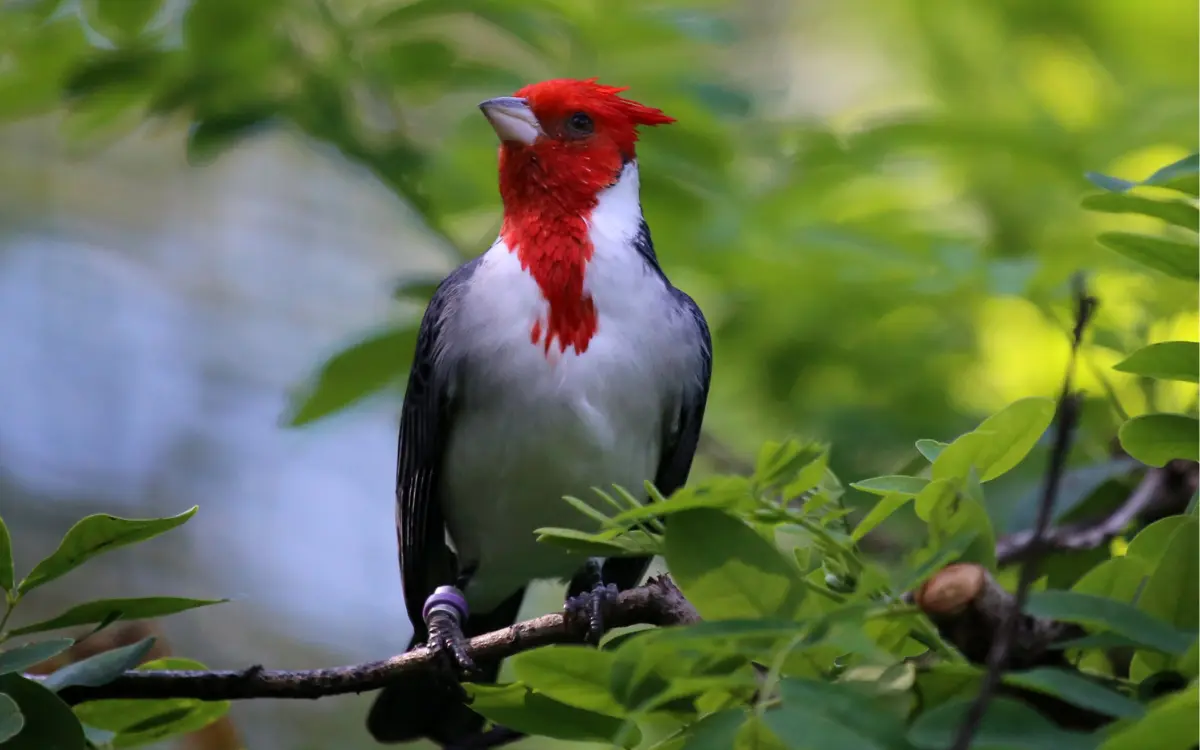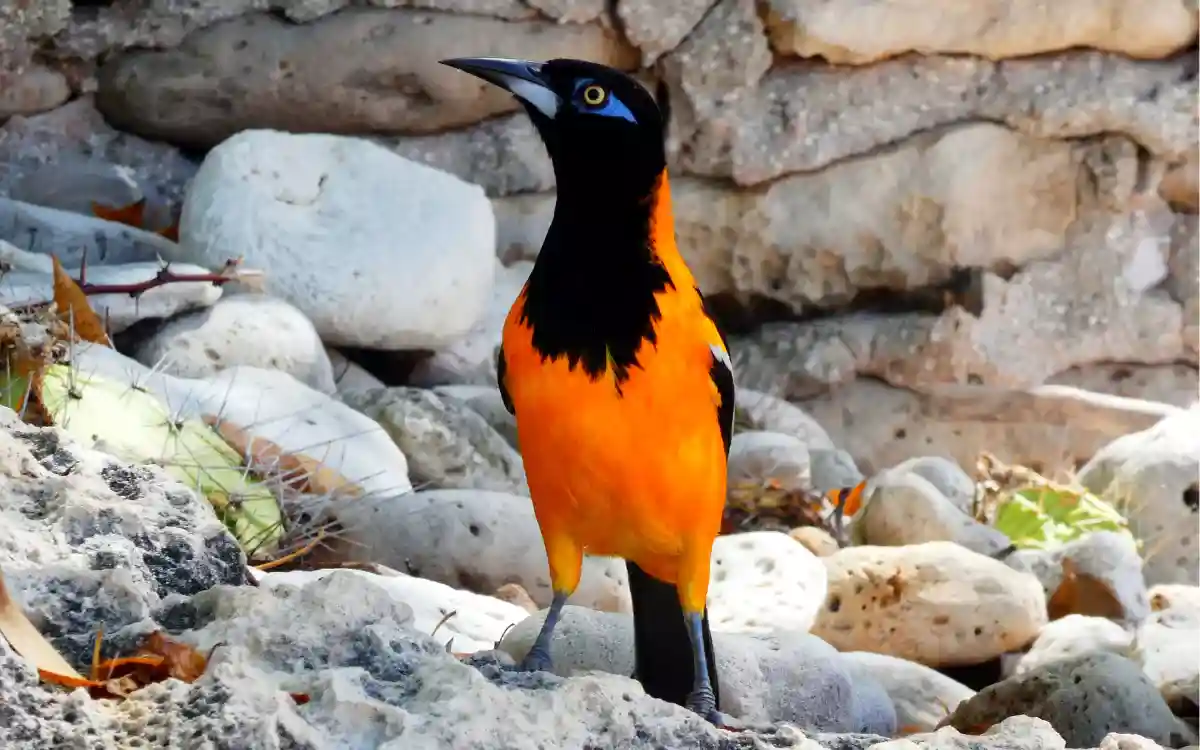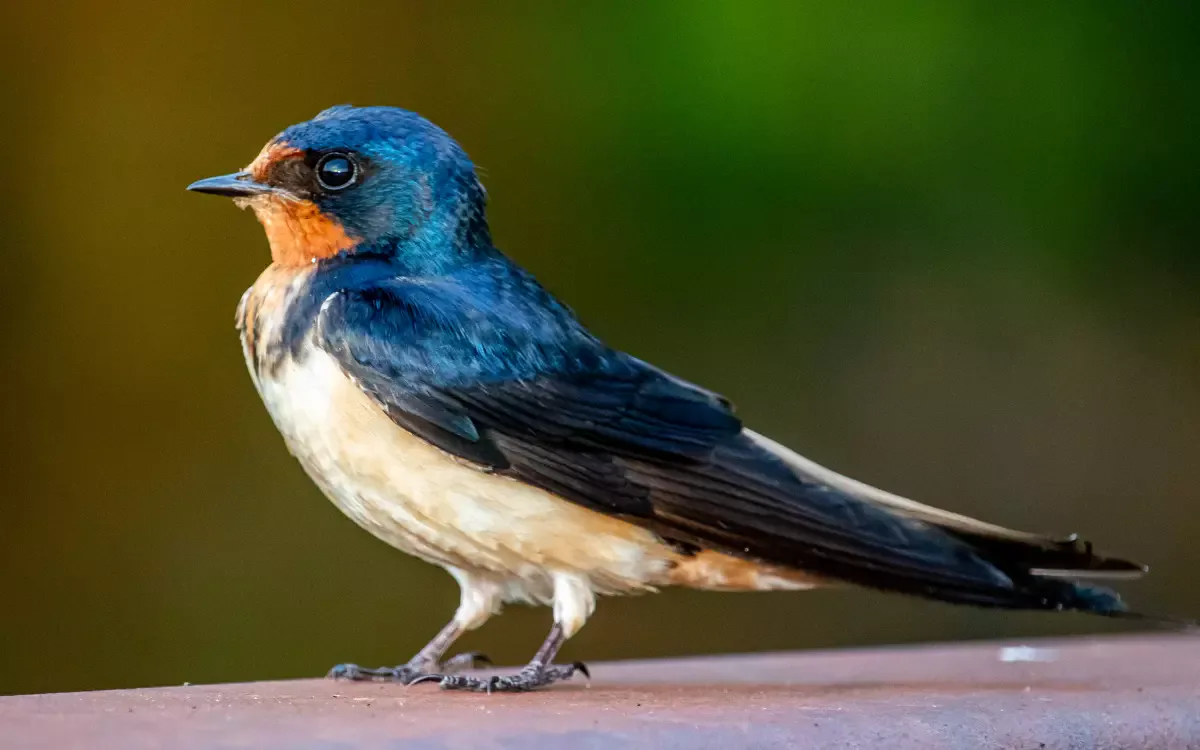16 Black Birds With White Bellies ( Picture & Id Guide)
White-bellied blackbirds are eye-catching birds in the bird world. This article will talk about 16 of these birds and what makes them special. We’ll learn about their unique features that make them different from other birds.
16 Black Birds With White Bellies:
1. Razorbill :
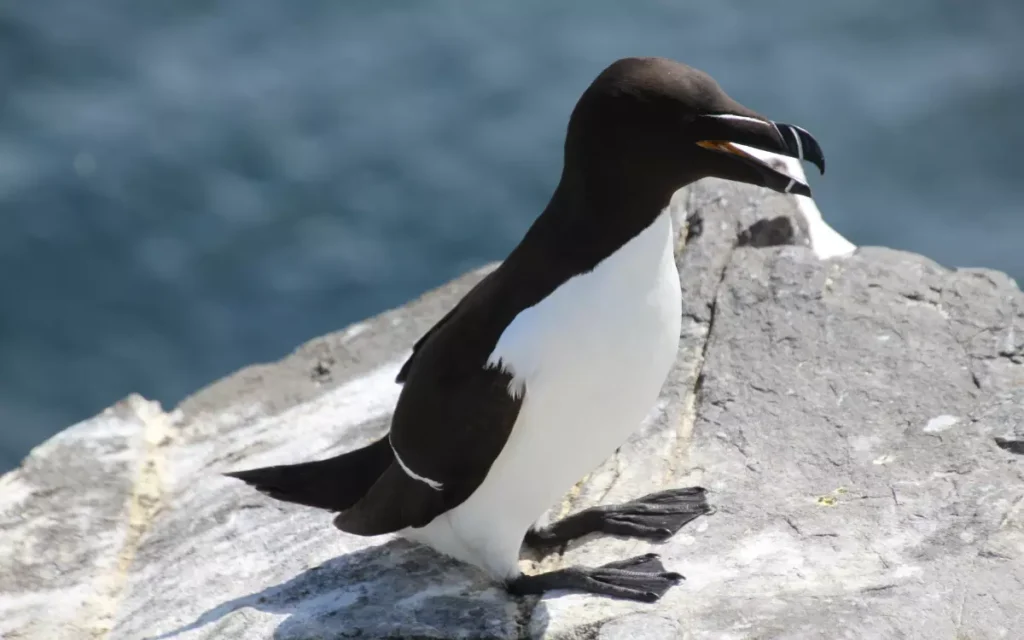
The Razorbill is a seabird species found in the North Atlantic Ocean. They have distinctive black plumage on their upperparts and white on their underparts, with a black beak that has a white vertical stripe. During the breeding season, they develop a horny plate on their beaks. Razorbills nest in colonies on cliffs or rocky shores.
They lay a single egg per breeding season. The egg is typically white with speckles and blotches, providing camouflage. Incubation lasts about 4-6 weeks, and both parents take turns incubating the egg and later feeding and caring for the chick. The young Razorbills fledge after about 30-40 days.
- Scientific Name: Alca torda
- Length: 16.9 in (43 cm)
- Wingspan: 24.8 – 26.8 in (63 – 68 cm)
- Weight: 17.8 – 31.4 oz (505 – 890 gm)
- Lifespan: 13 years
2. Spotted Towhee:
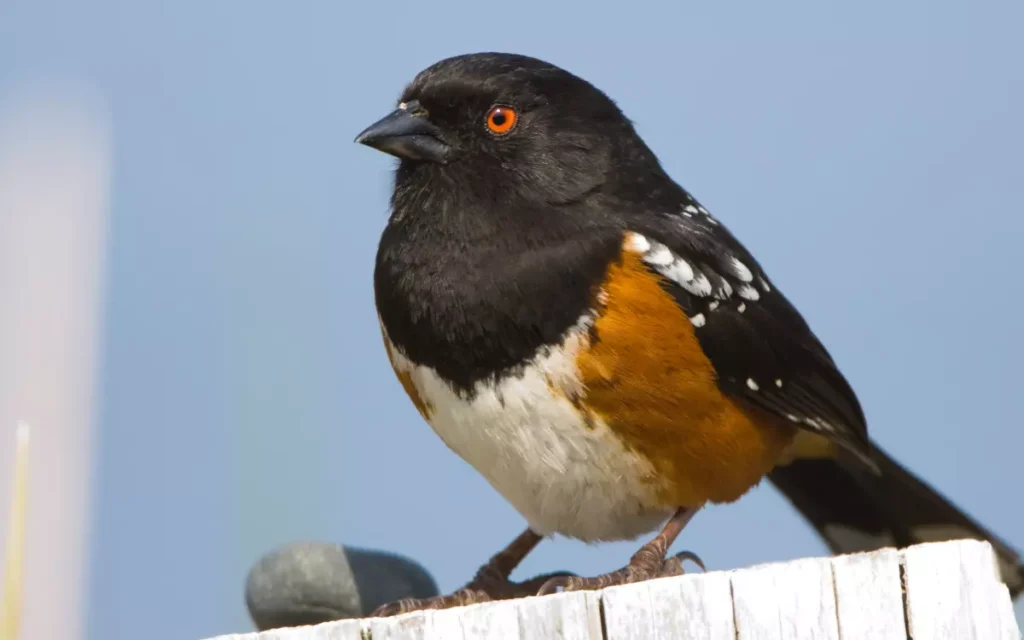
The Spotted Towhee is a North American bird with distinctive features. Males sport striking black plumage with white wing and back spots, red eyes, and a white belly.
Females exhibit browner hues with subdued markings. Their strong, conical beaks are adapted for ground foraging, feeding on seeds, insects, and plant matter.
Spotted Towhees construct cup-shaped nests using twigs, leaves, and grass, often positioned on the ground or low shrubs.
They typically lay 2-6 eggs, which are pale greenish-blue or bluish-white adorned with brown or lavender spots. Incubation takes about 12-14 days, with both parents nurturing the chicks until they fledge, around 10-12 days old.
- Scientific Name: Pipilo maculatus
- Length: 6.7- 8.3 in (17- 21 cm)
- Wingspan: 11 in (28 cm)
- Weight: 1.2 – 1.7 oz (33 – 49 gm)
- Lifespan: up to 11 years.
3. Ring-necked Duck (Female):
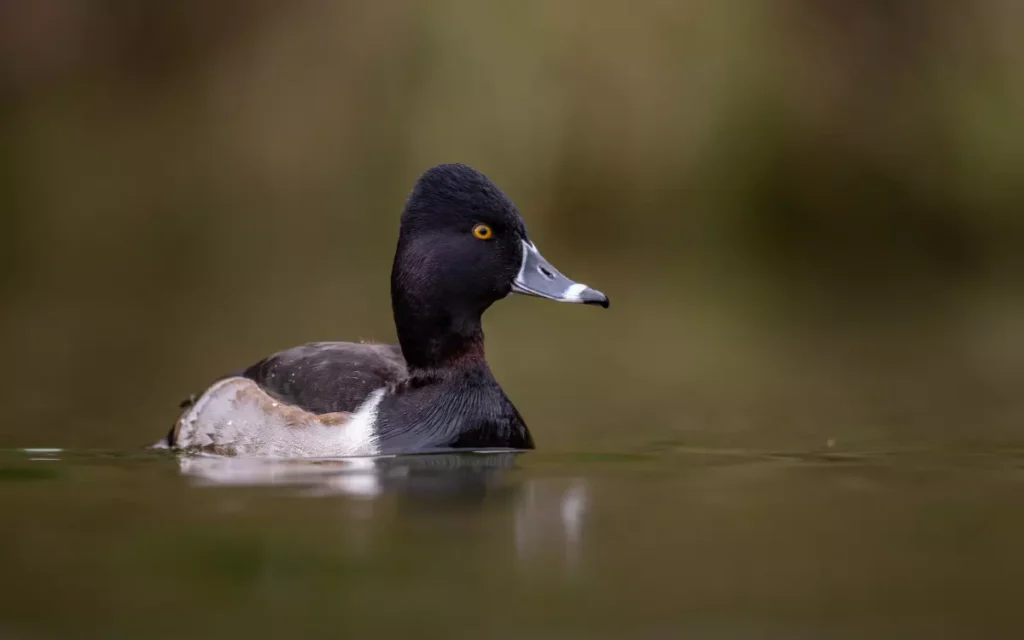
Ring-necked (Female) Ducks display muted brown plumage with a darker crown, contrasting with a white belly. They feature white eye rings encircling brown eyes and a distinctive thick white stripe behind the bill base. Their gray beaks have black tips with a white line near the end.
These ducks are cavity nesters, typically selecting concealed sites near freshwater lakes and wetlands. They lay 6-10 eggs, which are creamy white or pale green.
Ring-necked Ducks are proficient divers, feeding on aquatic plants, seeds, and insects underwater. They are often seen in mixed flocks during migration.
- Scientific Name: Aythya collaris
- Length: 15.3 – 18.1 in (39 – 46 cm)
- Wingspan: 24.4 – 24.8 in (62 – 63 cm)
- Weight: 17.3 – 32.1 oz (490 – 910 gm)
- Lifespan: At least 20 years, 5 months
4. Eastern Towhee:
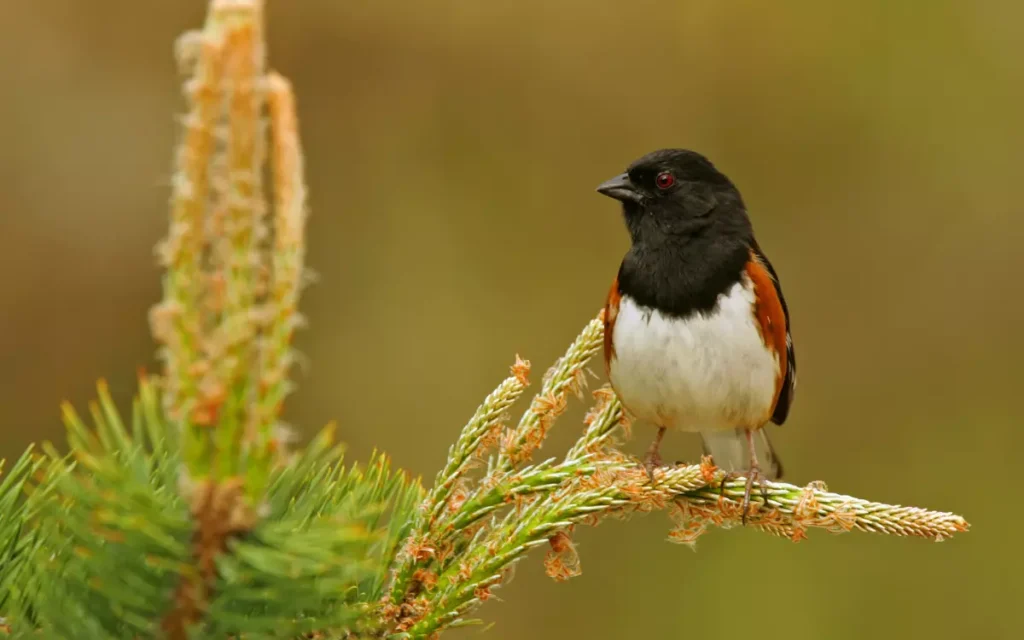
The Eastern Towhee is a distinctive bird found in North America. Males have striking black plumage with white bellies and bold red eyes. Their beaks are conical, and adapted for ground-feeding, primarily on insects and seeds. Towhees nest on or near the ground, creating nests made of twigs, leaves, and grasses.
They typically lay 2-6 eggs, which are pale blue-green or bluish-white with speckles. Incubation lasts about 12-14 days, with both parents sharing incubation duties. Once hatched, the chicks are cared for by both parents and fledge around 10-12 days old, transitioning from juveniles to adults.
- Scientific Name: Pipilo erythrophthalmus
- Length: 6.8 – 9.1 in (17.3 – 23 cm )
- Wingspan: 7.9 –11.8 in ( 20 – 30 cm).
- Weight: 1.1-1.8 oz (32 – 52 gm)
- Lifespan: Upto 12 years
5. White-breasted Nuthatch:
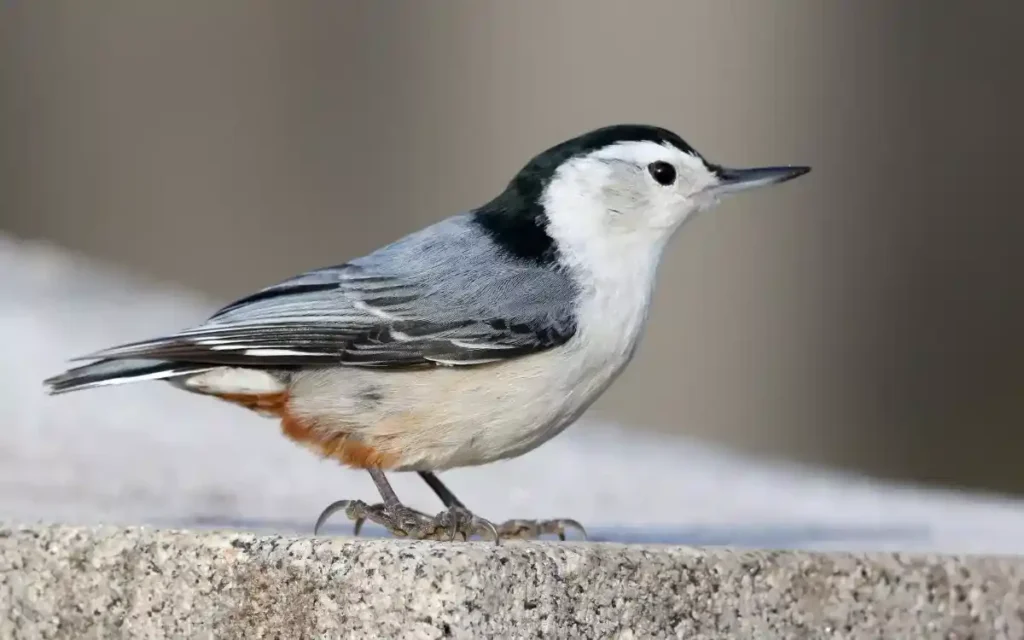
The White-breasted Nuthatch is a small songbird found in North America. They have striking blue-gray plumage on their upperparts, a white face, and a distinct black crown stripe. Their beaks are short and pointed, ideal for probing bark in search of insects and seeds.
Nuthatches nest in tree cavities, sometimes using abandoned woodpecker holes. They typically lay 5-9 eggs, which are creamy-white with fine brown speckles.
Incubation takes around 12-14 days, with both parents involved. After hatching, chicks are cared for by their parents and fledge about 26-28 days later.
- Scientific Name: Sitta carolinensis
- Length: 5.1- 5.5 in (13 -14 cm)
- Wingspan: 7.9 – 10.6 in (20 – 27 cm)
- Weight: 0.6 -1.1 oz (18 – 30 gm)
- Lifespan: about 2.5 to 3 years.
6. Barn Swallow :
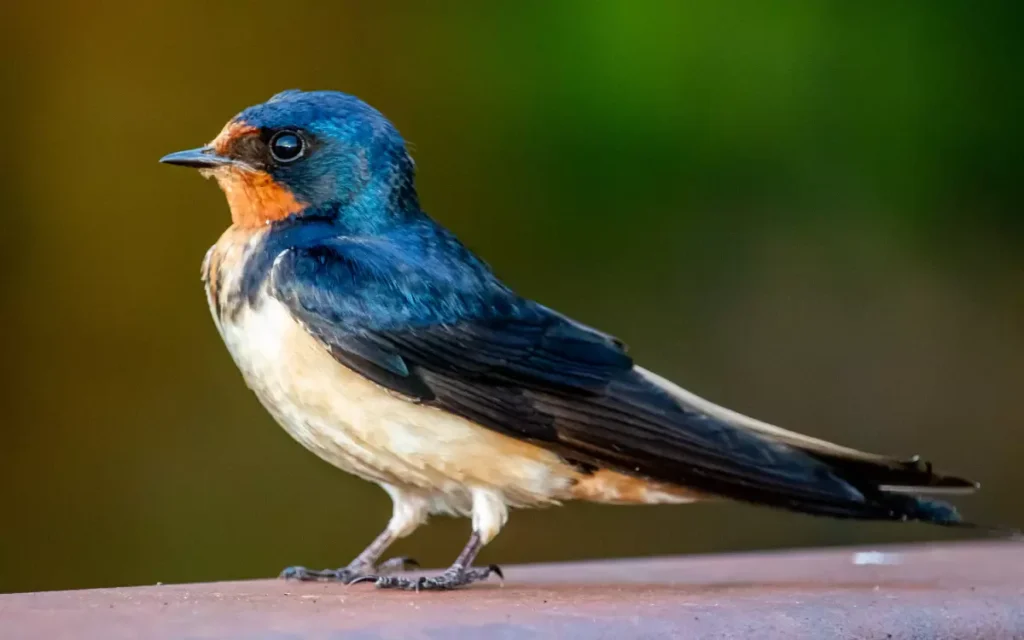
The Barn Swallow is a common bird known for its distinctive deep blue upperparts, rufous throat and forehead, and long forked tail. They have small, slender beaks, ideal for catching flying insects, their primary diet. These swallows build cup-shaped nests in sheltered locations like barns, under eaves, or on ledges.
The nests are constructed with mud and grass. They typically lay 4-6 eggs, which are white with speckles. Incubation lasts about 12-17 days, with both parents taking part. After hatching, chicks are cared for and fed by their parents and fledge approximately 18-23 days later
- Scientific Name: Hirundo rustica
- Length: 5.9 – 7.5 in (15 – 19 cm)
- Wingspan: 11.4 – 12.6 in (29 – 32 cm).
- Weight: 0.6 – 0.7 oz (17 – 20 gm) ·
- Lifespan: 4 to 8 years
7. Black-necked Stilt:
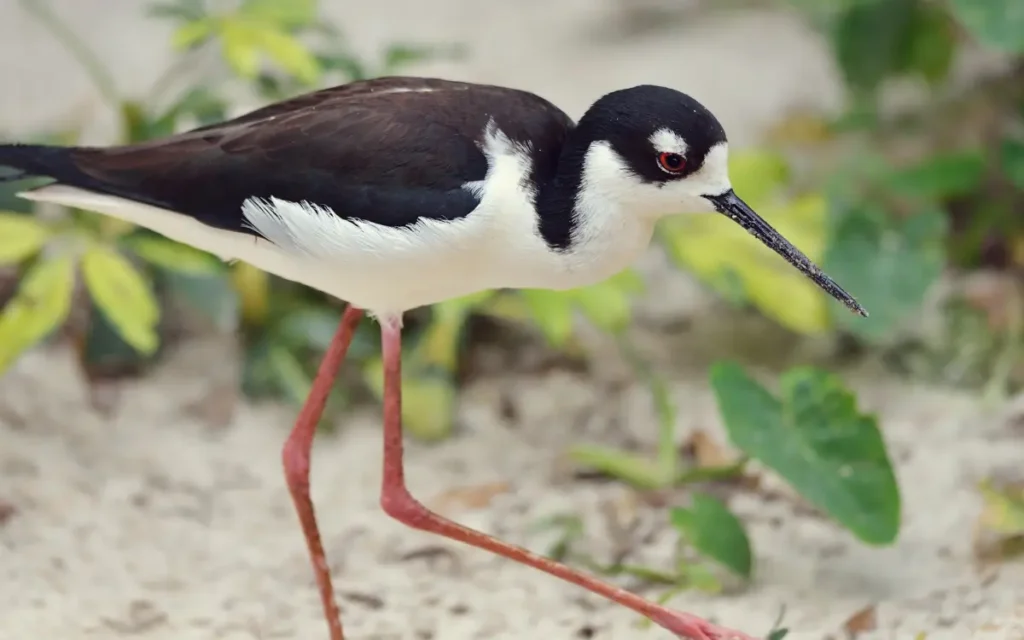
The Black-necked Stilt is a striking wader bird found in wetlands across North and South America. It features long pink legs and a distinctive black neck, back, and wings, with a white belly. Their slender, straight bills are used for foraging in shallow waters, primarily feeding on aquatic insects and small crustaceans.
They build their nests on the ground near water, forming shallow scrapes and lining them with shells and plant materials. They typically lay 2-5 eggs, which are cream to pale brown with brown spots. Both parents incubate the eggs, and chicks fledge around three to four weeks after hatching.
- Scientific Name: Himantopus mexicanus
- Length: 14 -15 in (35 – 39 cm)\
- Wingspan: 28 – 30 in (71 – 75 cm)
- Weight: 5 – 6 oz (150 -176 gm ).
- Lifespan: About 13 years
Related article:
8. Rose-Breasted Grosbeak:
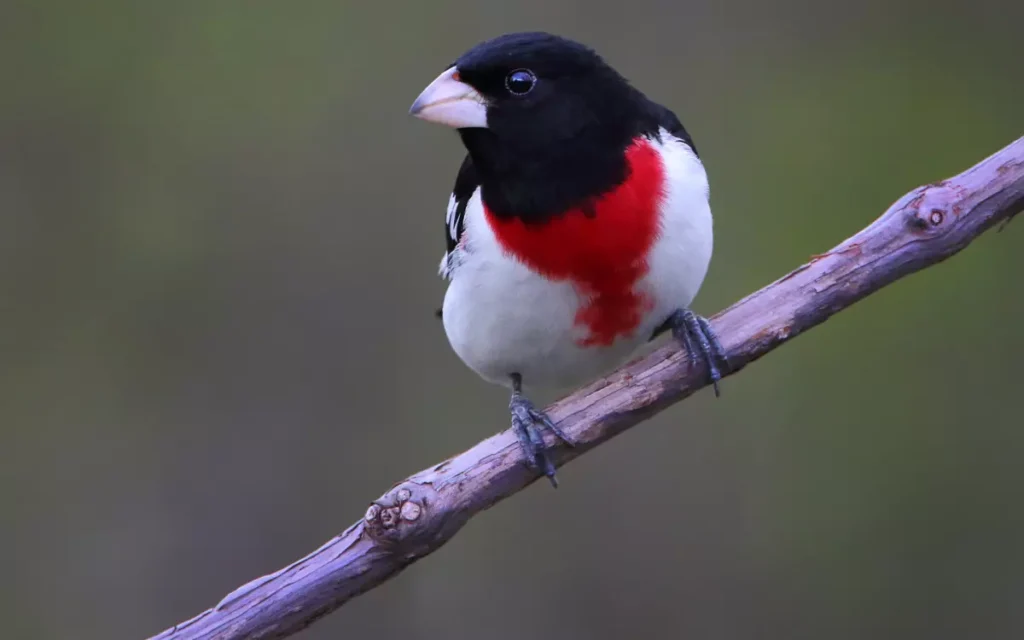
The Rose-breasted Grosbeak is a striking songbird found in North America. Males display black heads and wings, white underparts, and a distinctive rosy-red patch on their breasts. Their beaks are thick and conical, well-suited for cracking seeds. Grosbeaks nest in trees, constructing cup-shaped nests made of twigs, grass, and other materials.
They typically lay 3-5 pale blue-green eggs with brown speckles. Incubation lasts about 12-14 days, with both parents involved. After hatching, chicks are fed by their parents and fledge around 9-12 days old, transitioning from juveniles to adults.
- Scientific Name: Pheucticus ludovicianus
- Length : 7.1- 8.3 in (18 – 21 cm)
- Wingspan: 11.4 – 13 in (29 – 33 cm)
- Weight: 1.4 – 1.7 oz (39 – 49 gm)
- Lifespan : About 7.3 years
9. Hairy Woodpecker:
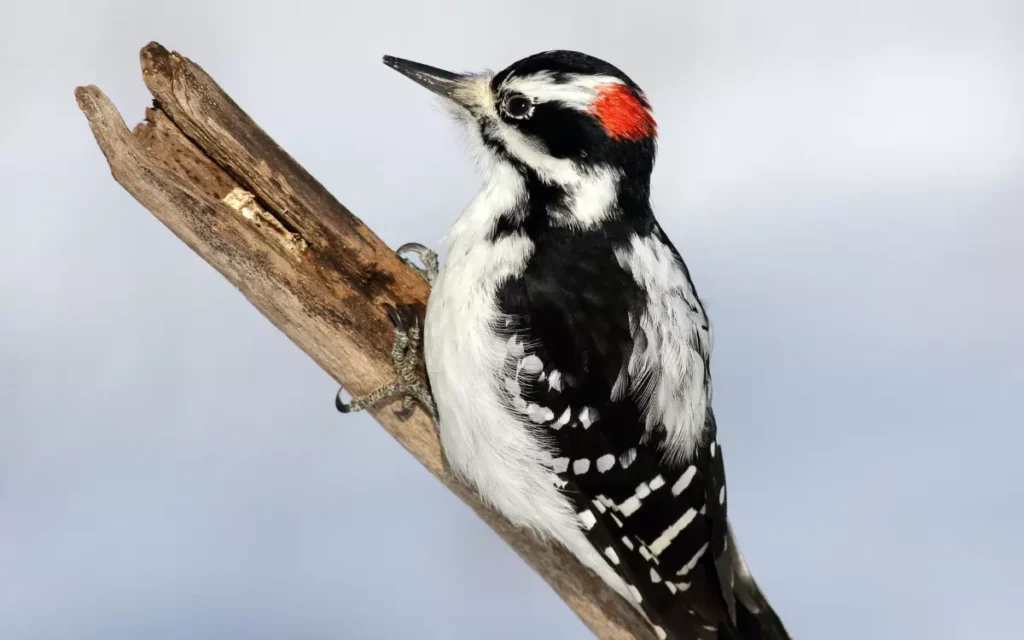
The Hairy Woodpecker is a medium-sized bird found in North America. It sports a black and white plumage with a white belly and a long, sturdy bill. These birds are skilled drummers, using their bills to tap on trees to find insects. Hairy Woodpeckers typically nest in tree cavities, often abandoned by other birds.
They lay 3-6 white, oval-shaped eggs. Incubation lasts around 11-12 days, and both parents share the responsibility. Once hatched, the young are fed a diet of insects and fruit. These woodpeckers are known for their distinctive calls and are important contributors to forest ecosystems by controlling insect populations.
- Scientific Name: Leuconotopicus villosus
- Length: 7.1 – 10.2 in (18 – 26 cm)
- Wingspan: 13.0 – 16.1 in (33 – 41 cm)
- Weight: 1.4 – 3.4 oz (40 – 95 gm)
- Lifespan: About 15 years
10. Eastern Kingbirds:
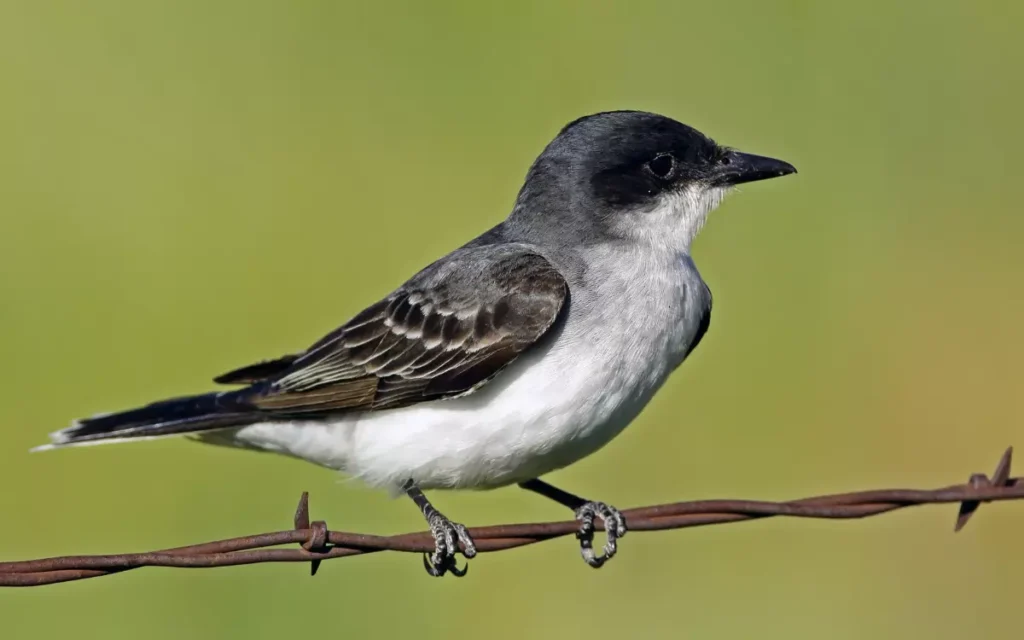
Eastern Kingbirds are striking birds found in North America. They have blackish-blue plumage on top with a white underside and a distinct white band on their tails. These agile birds are known for their aerial acrobatics.
They build cup-shaped nests in trees or shrubs, often near water. They lay 2-5 pale greenish-blue eggs. Both parents incubate the eggs and care for the chicks.
One fascinating fact about Eastern Kingbirds is their territorial nature, often fiercely defending their nesting sites, even against larger birds.
- Scientific Name: Tyrannus tyrannus
- Length: 7.5 – 9.1 in (19 – 23 cm)
- Wingspan: 13.0 – 15.0 in (33 – 38 cm)
- Weight: 1.2 – 1.9 oz (33 – 55 gm)
- Lifespan: About 10 years
11. Black Phoebe:
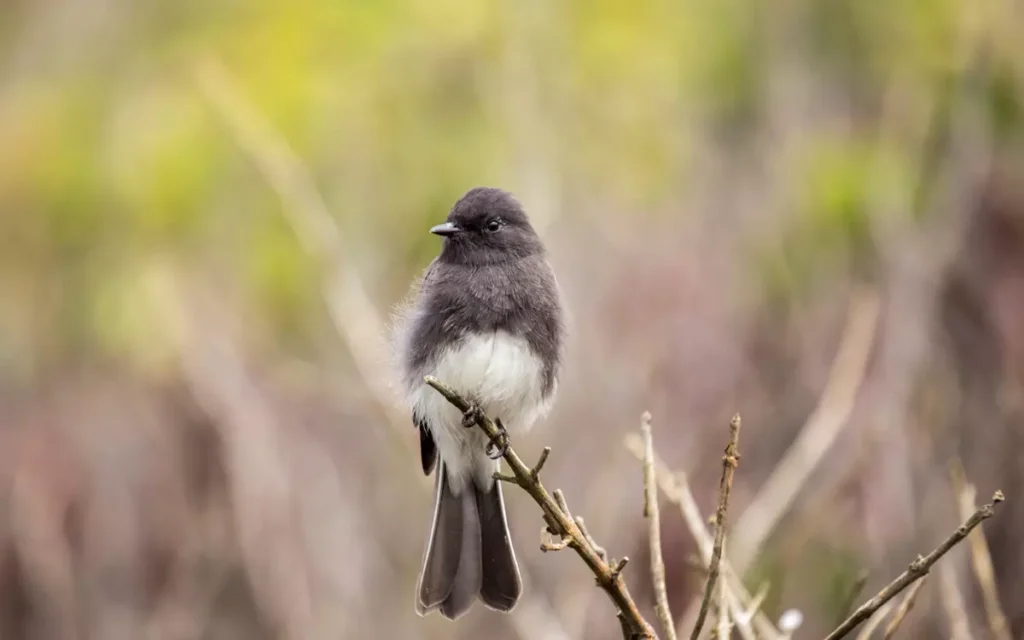
The Black Phoebe is a small, insect-eating bird found in the western United States. It has a predominantly black plumage with a white belly and a distinctive white patch on its wings. These birds build cup-shaped nests on ledges, walls, or bridges, often near water sources.
They lay 2-5 white eggs with brown speckles. Black Phoebes are known for their habit of repeatedly bobbing their tails and are skilled flycatchers, capturing insects in mid-air. A remarkable fact is their year-round territorial behavior and ability to adapt to urban environments.
- Scientific Name: Sayornis nigricans
- Length: 4.5 – 6.3 in (11.43 – 16 cm)
- Wingspan: 10 -11 in (25 – 28 cm)
- Weight: 0.5 – 0.8 oz (15 – 22 gm)
- Lifespan: About 8 years
12. Black Skimmer :
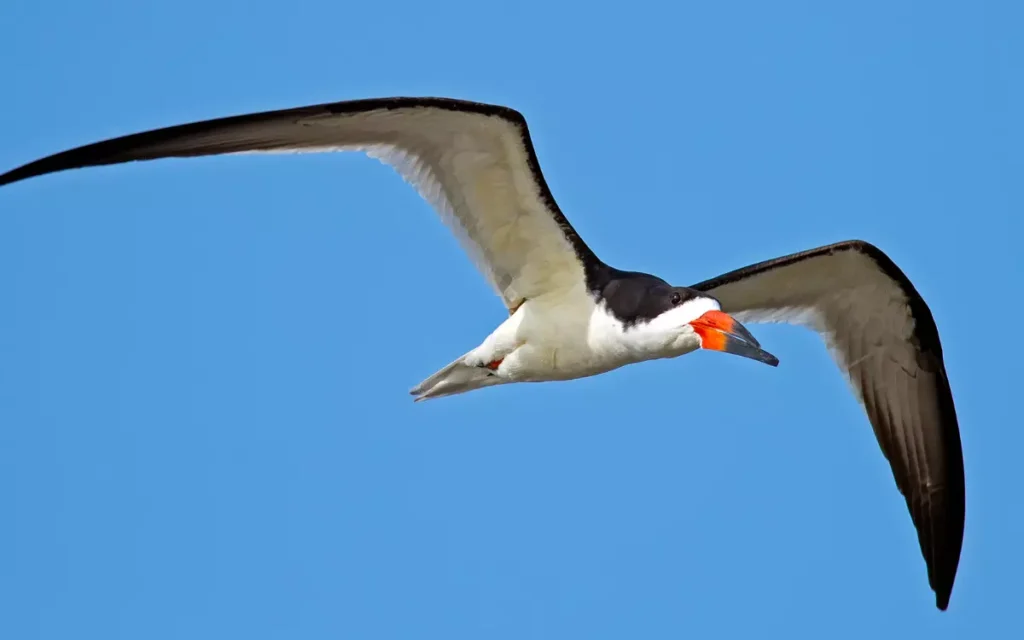
The Black Skimmer is a distinctive coastal bird primarily found in the Americas. It features striking black upperparts, a white underside, and a striking long orange bill with a lower mandible longer than the upper one. Black Skimmers nest in colonies on sandy beaches, laying 3-5 pale, buff-colored eggs with dark spots.
Their unique feeding behavior involves skimming their lower mandible through the water to catch fish, making them the only bird with a lower mandible longer than the upper. These birds are known for their dramatic, low-level flight while foraging and are skilled hunters.
- Scientific Name: Rynchops niger
- Length: 15.8 -19.7 in (40 – 50 cm)
- Wingspan: 42.9 – 45.3 in (109 -115 cm
- Weight: 9.3 -12.9 oz (265 – 365 gm)
- Lifespan: About 23 years
13. Downy Woodpecker:
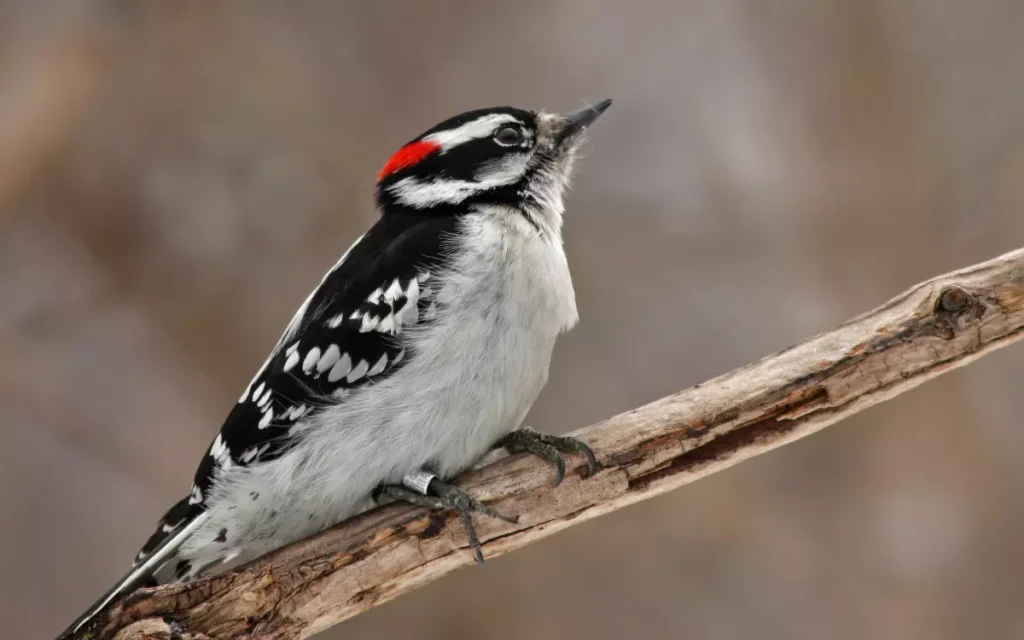
The Downy Woodpecker is a small North American bird, known for its black and white plumage, with a white belly, and distinctive ladder-like black markings on its back. They are the smallest woodpecker species in North America. They typically nest in tree cavities and lay 4-5 white, oval-shaped eggs.
Both parents take turns incubating the eggs and feeding the chicks. One interesting fact about them is their drumming pattern, which is slower and quieter compared to larger woodpecker species. They primarily feed on insects and tree sap, making them valuable for pest control.
- Scientific Name: Picoides pubescens
- Length: 5.5 – 6.7 in (14 – 17 cm)
- Wingspan: 9.8 -11.8 in (25 – 30 cm)
- Weight: 0.7- 1 oz (21 – 28 g)
- Lifespan: 1 to 2 years
14. Yellow-billed Magpie:
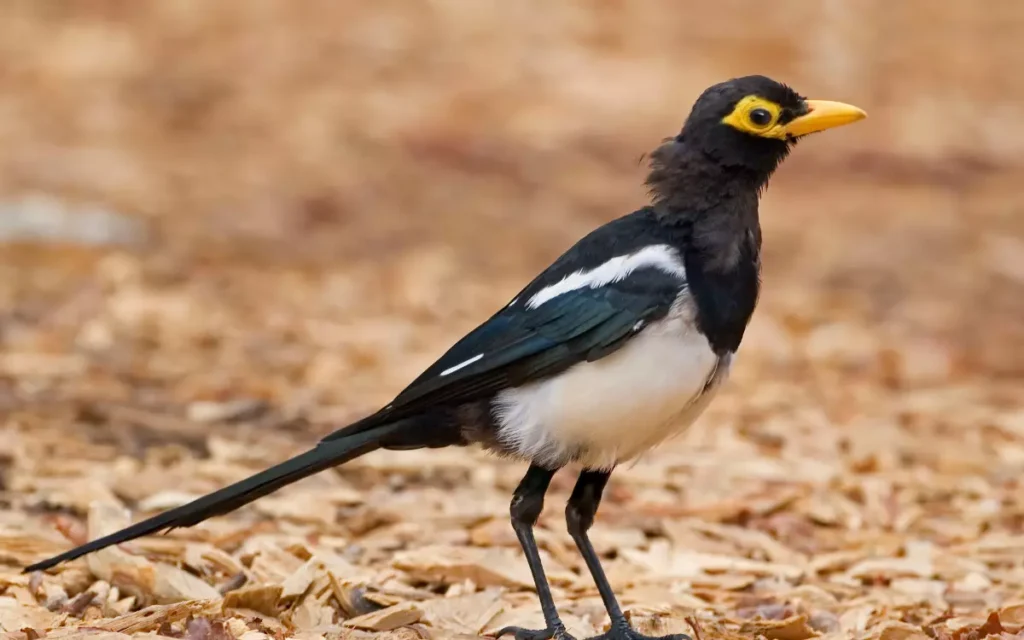
The Yellow-billed Magpie is a striking bird native to California. It boasts glossy black plumage with white markings, contrasting vividly with its distinctive yellow bill and bare yellow eye patch. These social birds build bulky nests in trees, often in colonies, using sticks and mud.
They typically lay 5-8 pale blue-green eggs. Yellow-billed Magpies are known for their intelligence, complex vocalizations, and cooperative breeding behavior, with family members helping to raise the young. They primarily feed on insects, fruits, and seeds.
- Scientific Name: Pica nuttalli
- Length: 16.9 – 21.3 in (43 – 54 cm)
- Wingspan: 24 in (61 cm)
- Weight: 5.3 – 6.0 oz (150 -170 gm)
- Lifespan: About 3 to 4 years
15. Black-billed Magpie:
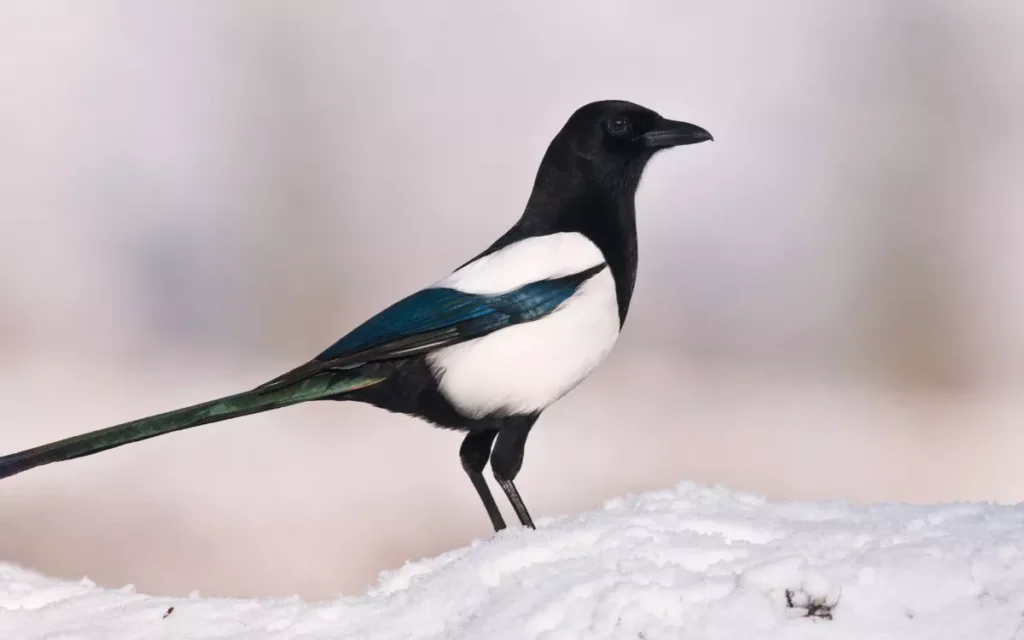
The Black-billed Magpie is a striking bird found in North America. It features black plumage with iridescent blue-green highlights, a long tail, and a sharp black bill.
They build large, dome-shaped nests made of sticks and grass, typically placed in trees.
They lay 5-9 pale greenish-blue eggs. These highly intelligent birds are known for their vocalizations, which include a variety of calls and even mimicry of other species. They have an omnivorous diet, feeding on insects, small mammals, seeds, and carrion.
- Scientific Name: Pica hudsonia
- Length: 17.7- 23.6 in (45 – 60 cm)
- Wingspan: 22.1 – 24.0 in (56 – 61 cm)
- Weight: 5.1 – 7.4 oz (150 – 210 gm)
- Lifespan: About 3 to 4 years
16. Atlantic Puffin:
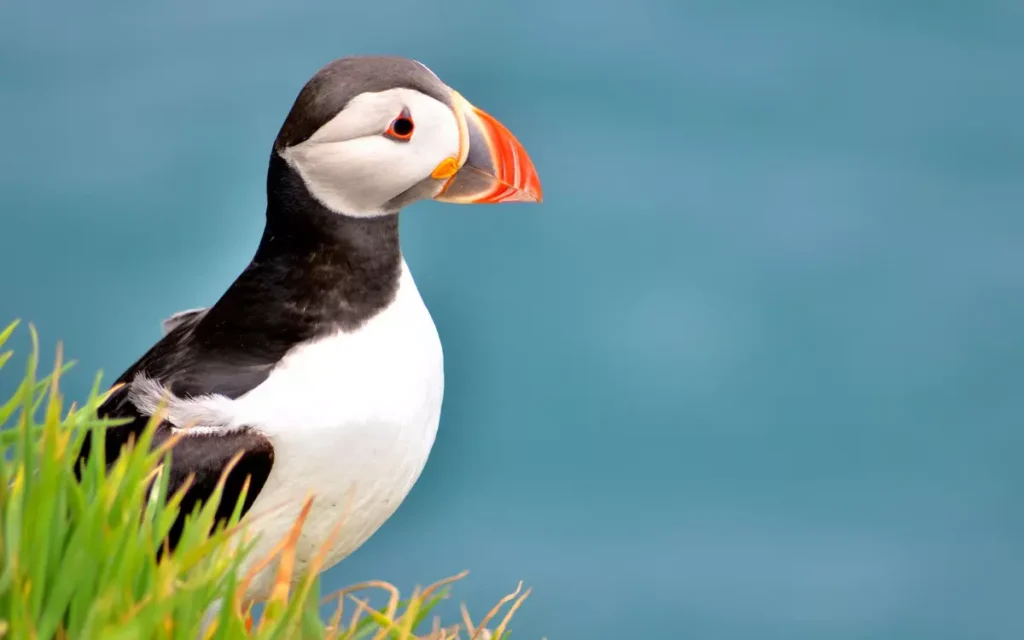
The Atlantic Puffin is a charming seabird found in the North Atlantic Ocean. It boasts a colorful appearance with a black back, white face, and distinctive bright orange bill.
These puffins nest in burrows on cliffs or rocky islands. They lay a single white egg per breeding season, and both parents share incubation and chick-rearing duties.
Remarkably, Atlantic Puffins are excellent swimmers and can catch numerous small fish on their bills during underwater dives. They are known for their comical appearance and are sometimes called “clowns of the sea.”
- Scientific Name: Fratercula arctica
- Length: 10.2 -11.4 in (26 – 29 cm)
- Wing span: 20.9 in (53 cm)
- Weight: 10.9 – 19.4 oz (310 – 550 gm)
- Lifespan: 15 to 30 years
FAQs:
Q: What is the scientific name of Black Birds With White Bellies?
A: The scientific name of these birds is “Turdus migratorius.”
Q: Are Black Birds With White Bellies considered a threatened species?
A: They are not currently considered threatened; however, their populations are closely monitored due to habitat concerns.
Q: Can these birds mimic other bird species’ calls?
A: Yes, Black Birds With White Bellies are known for their ability to mimic the calls of other bird species.
Q: How can I attract Black Birds With White Bellies to my backyard?
A: You can attract them by providing a bird-friendly environment with food, water, and suitable nesting locations.
Q: Do these birds have any cultural significance?
A: Yes, they hold cultural significance in some Native American tribes and folklore.
Q: What is the significance of the black birds’ white bellies?
A: The white belly serves as a distinctive feature for these birds, aiding in species identification and often playing a role in attracting mates.
Conclusion:
In the end, we’ve seen how special these 16 black birds with white bellies are. They teach us about the beauty of nature’s variety. Let’s keep caring for them so they can keep bringing joy to our world.


